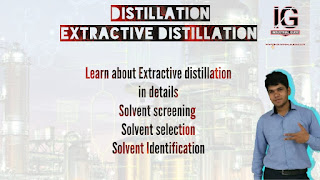Economic Extractive distillation (Definition, categories, Good Solvent selection criteria, Solvent screening)
Extractive distillation is defined as distillation in the present of a miscible, high boiling, relatively non-volatile component, the solvent, that forms no azeotropes with the other components in the mixture.
It is widely used in the chemical and petrochemical industries for separating azeotropic, close-boiling, and others low relative volatility mixture.
Extractive distillation works because the solvent is specially chosen to interact differently with the components of the original mixture, thereby altering their relative volatility.
Because these interactions occur predominantly in the liquid phase, the solvent is continuously added near the top of the extractive distillation column so that an appreciable amount is present in the liquid phase on all of the trays below.
The mixture to be separated is added through second feed point further down the column. In the extractive column, the component having the greater volatility, not necessarily the component having the lowest boiling point, is taken overhead as a relatively pure distillate.
The other component leaves with the solvent via the column bottoms. The solvent is separated from the remaining components in a second distillation column and then recycled back to the first column.
 |
Fig. 2 Extractive distillation with a heavy solvent which introduce no new azeotrope for a minimum boiling azeotrope. In some case, B can come off the top of the first column.
There are several industrial application for homogeneous azeotropic distillation listed in the Encyclopedia of Separation Technology by Michael F. D., Jeffrey P. K.
Extractive distillations can be divided into three categories, each correspond to the different residue curve maps,
- Minimum boiling azeotropes,
- Maximum boiling azeotropes
- Nonazeotrope mixtures.
Since our benzene-cyclohexane mixture to be separated is of the second type of mixture, i.e. the minimum boiling azeotrope,
we will focus our attention on column sequencing this type of azeotropic separation method in the following section.
As in azeotropic distillation, design of extractive distillation system will also requires significant preliminary work including:
- Choosing the solvent
- Developing or finding necessary data, such as azeotropic condition or residue curve
- Preliminary screening
- Computer simulation
- Small scale testing
For our example, we will consider the first four steps.
Solvent screening and selection
Solvent criteria
One of the most important steps in developing a successful (economical) extractive distillation sequence is selecting a good solvent.
Approaches to the selection of an extractive distillation solvent are discussed by Berg, Ewell et al. and Tassions. In general, selection criteria include the following:
- Should enhance significantly the natural relative volatility of the key component.
- Should not require an excessive ratio of solvent to non solvent (because of cost of handling in the column and auxiliary equipment.
- Should remain soluble in the feed components and should not lead to the formation of two phases.
- Should be easily separable from the bottom product.
- Should be inexpensive and readily available.
- Should be stable at the temperature of the distillation and solvent separation.
- Should be nonreactive with the components in the feed mixture.
- Should have a low latent heat.
- Should be noncorrosive and nontoxic.
Naturally no single solvent or solvent mixtures satisfy all the criteria, and compromises must be reached.
Solvent screening
Perry's handbook serve as a good reference for the solvent selection procedure, which can be thought of as a two-step process, i.e.:
First level: Broad screening by functional group or chemical family
1. Homologous series: Select candidate solvent from the high boiling homologous series of both light and heavy key components.
2. Robins Chart: Select candidate solvents from groups in the Robbins Chart (part of the chart is shown in Table 3) that tend to give positive (or no) deviations from Raoult's law for the key component desire in the distillate and negative (or no) deviations for the other key.
3. Hydrogen-bonding characteristic: are likely to cause the formation of hydrogen bonds with the key component to be removed in the bottoms, or disruption of hydrogen bonds with the key to be removed in the distillate. Formation and disruption of hydrogen bonds are often associated with strong negative and positive deviations, respectively from Raoult's Law.
4. Polarity characteristic: Select candidate solvents from chemical groups that tend to show higher polarity than one key component or lower polarity than the other key.
Identification of individual candidate solvents
1. Boiling point characteristic: Select only candidate solvents that boil at least 30-40oC above the key components to ensure that the solvent is relatively nonvolatile and remains largely in the liquid phase.
With this boiling point difference, the solvent should also not form azeotropes with the other components.
2. Selectivity at the infinite dilution: Rank the candidate solvents according to their selectivity at infinite dilution.
Experimental measurement of relative volatility: Rank the candidate solvents by the increase in relative volatility caused by the addition of the solvent.
3. Residue curve maps are of limited usefulness at the preliminary screening stage because there is usually insufficient information available to sketch the them, but they are valuable and should be sketched or calculated as part of the second stage of the solvent selection
Read more about "Distillation" from Industrial Guide - Click here
Important linksWikipedia
Read on Science direct
Read on Epic Modular Processes
